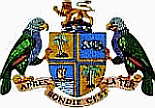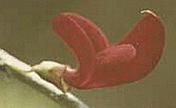




|

A. Fortune
Plant Family: Belongs to the Podocarpaceae or Yew family, a primarily tropical family, which includes P. trinitensis of Trinidad, P. brasiliensis of Brazil, and P. roraimae of the Guyana highlands; these are gymnosperms (evergreens) like pines, spruces and cycads.
Description: Spindly West Indian evergreen, resinous, dioecious, with straight trunk, more or less horizontal branches and small canopy, up to15m tall (50 ft) depending on location; bark smooth, thick and mossy; leaves medium to long, 7.5 to 17.5 cm, lanceolate, dark green and leathery, with strong odor when crushed; male cones with numerous bracts; female cones usually 2-4 scales, often only 1 or 2 scales bearing ovules. Seed with a fleshy, red or purple receptacle
Natural Habitat: Moist to very wet, mossy montane thicket - transitional between elfin woodland and montane forests; on flat upland to steep mountain slopes; tolerating very heavy rainfall and high wind.
Origin and Distribution: Native to wet, upland areas of several Caribbean islands; most common tree found in Dominica's montane thicket vegetation on steep high mountain slopes of Morne Diablotin, Morne Nicholls, and Trois Piton; but will grow at lower elevations with moderate rainfall. In the Botanic Gardens it grows at an elevation of about 22 m (70 ft) with rainfall about 85 inches (33 cm); the island's only native conifer.
Uses: Caribbean farmers use logs for fence posts and small log cabins (cabets). Occasionally grown as an ornamental in Dominica (Vieille Case, Fort Young Hotel and the Botanic Gardens).
References:
J. Higgins. Podocarpus coriaceus. New York Botanic Garden reports, NY, NY; 1994
W.S. Judd et. al. Podocarpus coriaceus. New York Botanic Garden reports, NY, NY; 1992
World Heritage Sites. Morne Trois Pitons National Park, Dominica. UNEP, Cambridge, UK; 1997
"Podocarpus coriaceus" in Gymnosperm Database (conifers.org). Christopher J. Earle (ed). Bonn University, Bonn, Germany; 2001
Robert A. DeFilipps. Useful Plants of the Commonwealth of Dominica, West Indies. Smithsonian Institution. Washington, DC 20560; 1998.
|



